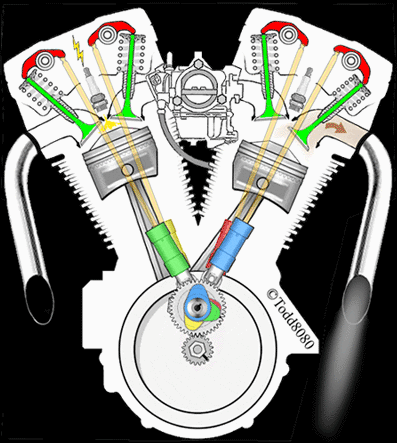There are a bunch of different engine sounds out there... cars, airplanes, boats, lawnmowers, motorcycles and more. Motorcycles though are probably the most unique because virtually no two sound alike. Not only does each style of motor have a distinct sound, but even identical motors are given a more distinct sound by their owners. But one motorcycle, no matter how you change the volume or pitch, can always be identified by its unique rhythm... the famous potato-potato-potato sound of the Harley-Davidson V-Twin motor. This sound is so tied to the brand that Harley-Davidson even applied for a trademark on it at one time.
So why does the Harley-Davidson V-Twin have such a unique rhythm?
 Engine noise is produced by the compressed gases exiting the cylinders though the exhaust valves and then through the exhaust system where they are either muffled or amplified depending on your exhaust system and muffler setup. In a typical two cylinder motor the crankshaft has two separate pins for the pistons' connecting rods and the spark plugs are positioned 180° from each other. Each piston fires on every other rotation of the crankshaft and with the sparks plugs at 180° from each other; this provides a smooth, even rhythm sound.
Engine noise is produced by the compressed gases exiting the cylinders though the exhaust valves and then through the exhaust system where they are either muffled or amplified depending on your exhaust system and muffler setup. In a typical two cylinder motor the crankshaft has two separate pins for the pistons' connecting rods and the spark plugs are positioned 180° from each other. Each piston fires on every other rotation of the crankshaft and with the sparks plugs at 180° from each other; this provides a smooth, even rhythm sound.
However the classic Harley-Davidson engines are V-twin engines, with a 45° angle between the cylinders. The crankshaft has a single pin, and both pistons are connected to this pin through their connecting rods. This 45° angle is covered under several United States patents and is an engineering tradeoff that allows a large, high-torque engine in a relatively small space. It causes the cylinders to fire at uneven intervals and produces the choppy "potato-potato" sound so strongly linked to the Harley-Davidson brand.
To simplify the engine and reduce costs, the V-twin ignition was designed to operate with a single set of points and no distributor. This is known as a dual fire ignition system, causing both spark plugs to fire regardless of which cylinder was on its compression stroke, with the other spark plug firing on its cylinder's exhaust stroke, effectively "wasting a spark". The exhaust note is basically a throaty growling sound with some popping. The 45° design of the engine thus creates a plug firing sequencing as such: The first cylinder fires, the second (rear) cylinder fires 315° later, then there is a 405° gap until the first cylinder fires again, giving the engine its unique sound.
August 5, 2011- -
-
Report
August 5, 2011- -
-
Report
August 5, 2011- -
-
Report
I am on a single pin also,yet its a Honda homage to The motor company,still it really has its own unique sound ,similiar... more
August 7, 2011- -
-
Report